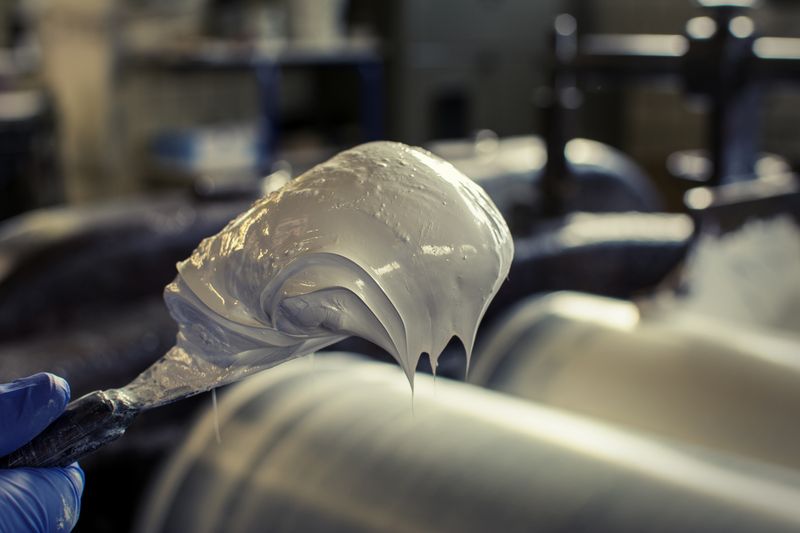Colour Paste
Free of solvents, resins or other additives, our linseed oil paste is made of high quality linseed oil and pure pigments. The manufacturer of our linseed oil pastes and linseed oil colours, Original Linoliemaling, is an established Danish factory. The pastes which are created on a triple-roll mill are based on proven formulas that have been passed down for generations traditionally. The ground paste is the ideal foundation for mixing a linseed oil paint. So you can mix your colour according to your own criteria, determine the amount of oil itself and match the surface on which it is applied. You even determine the amount of linseed oil and the amount of drying accelerators to be used and know exactly what you will hold in your hands.
Linseed oil pastes are derived from in Linseed oil ground pigments. In order to produce a colour paste, pigments and linseed oil are triturated or mixed repeatedly with each other on a roller. The consistency is similar to that of an artist paint from the tube. Before the pastes can be used as a colour, it must be mixed with linseed oil and some desiccant.
A spreadable finished paint is usually made of a ratio of 1: 1, a cup of colour paste per cup of cold pressed linseed oil. Since each pigment has different drying properties, the amount of desiccant that has to be added to the respective colour varies. Between 4-8ml per 1kg desiccant of paste to the finished colour should be added. For the proper instructions on the mixing of linseed oil colours, refer to the "Applications," section of this website. You will find additional information about working with linseed oil paints.
A video of our Manufacturer Original Linoliemaling from Denmark can be found in our blog. The pastes, depending on their level of pigments contained, can be stored for years, remaining unchanged in their application properties and composition. The pastes can easily be prepared by mixing the necessary amount of linseed oil. Linseed oil paints are very plentiful. It is so easy to mix the pastes with the required amount of linseed oil. You can even do it right in your own home. The remaining paste may be stored away for later use. Highly absorbent surfaces require a larger amount of colour (meaning a higher proportion of linseed oil), low absorbent surfaces require more of a lean colour (higher paste content). This allows full control over the overall composition needed and get the most out of such a fantastic product.
Linseed oil can be stored for up to -15 ° C.
Step 1
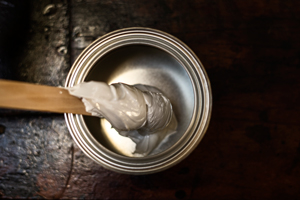 Fill in the desired quantity of colour paste into an appropriate container. Tap the container on a flat table gently, until the colour paste forms an even surface.
Fill in the desired quantity of colour paste into an appropriate container. Tap the container on a flat table gently, until the colour paste forms an even surface.
Step 2
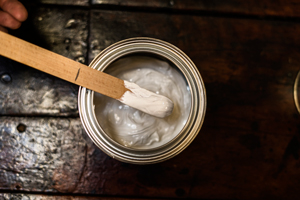 The finished linseed oil paint consists of an equivalent mixture of boiled linseed oil (also known as linseed oil varnish) and pigmented paste. In order to determine the amount of paste easier, simply place a wooden stir stick vertically into the colour paste. The wooden stick makes it easier to accomplish the amount of paste desired. Double the amount on the stick and then mark it for the next final step.
The finished linseed oil paint consists of an equivalent mixture of boiled linseed oil (also known as linseed oil varnish) and pigmented paste. In order to determine the amount of paste easier, simply place a wooden stir stick vertically into the colour paste. The wooden stick makes it easier to accomplish the amount of paste desired. Double the amount on the stick and then mark it for the next final step.
Step 3
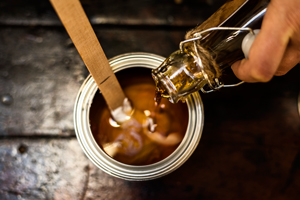 Now you add the boiled linseed oil the colour paste. Pour small amounts into the container at a time while stirring paste and linseed oil together well. Does the container have as much colour as previously marked on the wooden stir stick.
Now you add the boiled linseed oil the colour paste. Pour small amounts into the container at a time while stirring paste and linseed oil together well. Does the container have as much colour as previously marked on the wooden stir stick.
Step 4
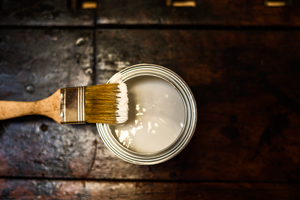 The linseed oil paint is ready.
The linseed oil paint is ready.
Practical tips in dealing with Linseed oil paste
Leftover linseed oil paste can be well kept when it, for example, is transferred to a jam or jelly jar. It is important to fill the glass to the brim with cold pressed linseed oil. Otherwise there will be a skin like appearance on the surface which may affect the overall paint quality after being exposed to air. This way, the colour paste can be stored for many years.
- :


